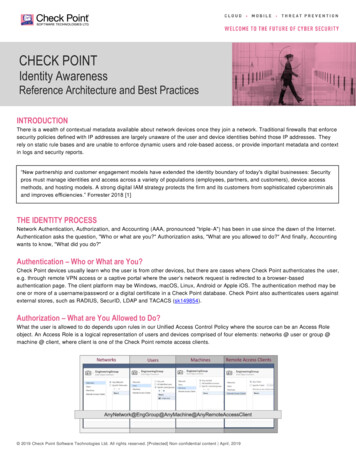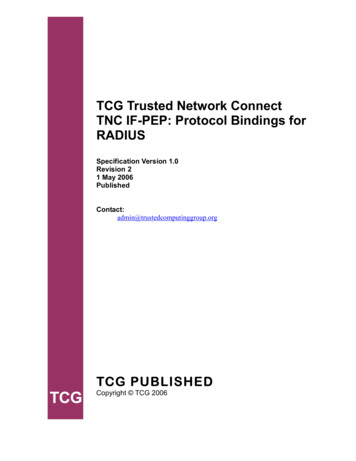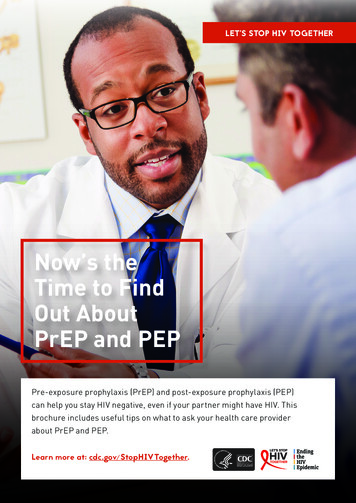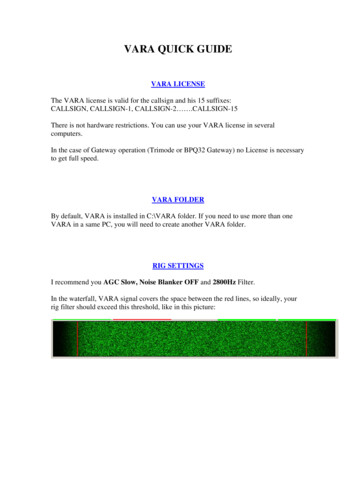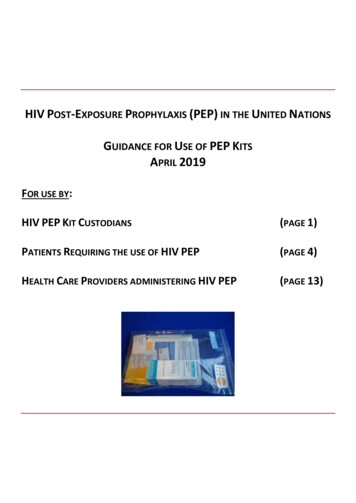
Transcription
HIV POST-EXPOSURE PROPHYLAXIS (PEP) IN THE UNITED NATIONSGUIDANCE FOR USE OF PEP KITSAPRIL 2019FOR USE BY:HIV PEP KIT CUSTODIANS(PAGE 1)PATIENTS REQUIRING THE USE OF HIV PEP(PAGE 4)HEALTH CARE PROVIDERS ADMINISTERING HIV PEP(PAGE 13)
HIV PEP: Custodian Information1HIV POST-EXPOSURE PROPHYLAXIS (PEP) KITS:INFORMATION FOR CUSTODIANS11WHAT IS PEP?PEP stands for “Post Exposure Prophylaxis”. In the context of HIV, it refers to a set of services that areprovided to manage the specific aspects of exposure to HIV and to help prevent HIV infection in anexposed person. These services might comprise first aid, counselling, including the assessment of risk ofexposure to HIV, HIV testing, and depending on the outcome of the exposure assessment, a course of antiHIV medication, with appropriate support and follow-up. PEP should be initiated as soon as possible afterexposure, ideally within 2 hours or less, and no later than 72 hours post-exposure. Adherence to a full 28day course of anti-retroviral (ARV) medicines is critical and the administration of PEP should be providedwith comprehensive services in a confidential and trusting environment. Providing assurance andmaintaining confidentiality of exposed individuals in all dealings and communications is vital.The UN Medical Services recommendations for PEP are based on careful review of available studies andconstitute the considered opinion of international HIV experts. To access the reference for this guidancedocument, please see 9789241508193 eng.pdf.2PEP KITSUN PEP Kits are provided to duty stations in the field to facilitate prompt access to medication in case ofpotential exposure to HIV, allowing the time to organize referral to a trained service provider who willensure treatment care and support throughout the full 28-day course of PEP medicines and when deemedappropriate, a medical evacuation to more adequate facilities.The PEP Kits contain sufficient anti-HIV medications to cover twenty-eight days’ of a three-drug antiretroviral treatment, supplied as two separate combination tablets: Tenofovir Disoproxil Fumarate 300mg Lamivudine 300mg (1 fixed-dose combination tablet, taken once daily) and Lopinavir (LPV) 200mg Ritonavir (r),50 mg (two fixed-dose combination tablets, taken twice daily). The full course of PEP is for 28 days and it iscritical to ensure the treatment’s continuity.Other contents of kits include: Pregnancy test kit: to identify if an exposed women was already pregnant before potential exposureto the virus. Pregnant women can take PEP and the risk benefit needs to be discussed with theclinician. Emergency oral contraception ("morning-after" pill); 1 tablet of Levonorgestrel to preventunwanted pregnancy after sexual exposure to take as soon as possible and no later than 5 days afterexposure. Patient Registry Form: to be filled and signed by the treating physician who will monitor the care.1This document should be used in conjunction with Appendix 2, UNSMS Security Management Operations Manual “Guidelines on theManagement of HIV Post-Exposure Prophylaxis (PEP) Kits.”
HIV PEP: Custodian Information32ELIGIBILITYUN PEP Kits are available to all UN Security Management System Personnel and their eligibledependents2 who may have been accidentally exposed to HIV, regardless of means of exposure.4DUTIES OF THE CUSTODIAN3A. Ensure safe and proper storage. The kits should be kept in a secure space that is locked. Theyshould be stored according to manufacturer’s instructions, stored in closed containers, attemperatures between 15 o C and 30o C (no refrigeration required) and kept dry and protected fromlight, humidity and excessive heat.B. Maintain adequate supplies to ensure uninterrupted availability. Custodians should maintainproper inventory records of the kits, including recording of expiry dates. Custodians shoulddetermine when to reorder supplies, place orders to replenish supplies4, and promptly record newstock when received.C. Manage PEP kit requests, by doing the following.1. Ensure person requesting PEP is administratively eligible, as someone covered by the UnitedNations Security Management System5.2. Accompany person requesting kit to a physician (if custodian is not a physician) for riskassessment.3. Release kit to physician who is attending to the person in need.D. Ensure confidentiality of all related information and documentation. Custodians must, at all times,maintain the strictest confidentiality in all dealings and communications surrounding the case.E. Ensure 24-h access to the kits. Custodians should be contactable at all times and ensure 24-houravailability of the PEP kits to staff. If the custodian is a health care provider, he or she may beauthorized to initiate treatment with the PEP kit. Non-medically qualified custodians will have tocontact the physician/s indicated in the HIV PEP Annex to the Country Security Plan, who willconduct a risk assessment and administer the kit, if warranted.F. Provide advice to staff in isolated locations who cannot see a health care provider within 72hours. In such cases, the custodian should advise exposed persons to call a centre of excellence onHIV, as listed in the Appendix 2 of the UNSMS Security Management Operations Manual “Guidelineson the Management of HIV Post-Exposure Prophylaxis (PEP) Kits,” which each country should establish,circulate and keep with the kits. A medical provider at the centre of excellence can perform a risk2This refers to a broad range of UN system personnel, and those from affiliated organizations, who fall under the United Nations SecurityManagement System, as defined in Chapter III of the United Nations Security Policy Manual on the Applicability of the United Nations SecurityManagement System. The full text of that document can be found in Annex 4.3 Custodians should always be a UN system staff member. The only authorized exception relates to UN Examining Physicians (UNEPs) who maybe designated as custodians – if they agree to do so, and only if all of the contents of the kit (including emergency contraception) are legal inthe country in question.4 The custodian should request replenishments of kits msdpublichealth@un.org.5 See footnote 2, above.
HIV PEP: Custodian Information3assessment over the telephone. If not available, the requestor should contact their organization’sheadquarters Medical Service emergency line to receive advice.More information can be found in the Health Care Provider and Patient Information Sheets.
PEP: Patient Information4PATIENT INFORMATION SHEET 1:HIV AND OCCUPATIONAL EXPOSURE TO BLOOD OR BODYFLUIDS: WHAT YOU NEED TO KNOWSeveral infectious diseases are spread by contact with an infected person’s blood or their body fluids ortissues. Hepatitis B, hepatitis C and HIV infection are examples of diseases that are spread in this way.Someone may be infected with one of these viruses without even knowing it – and you may not realizethat their body fluids or tissues are infectious.If you have been exposed to someone’s body fluids or tissues – through an accidental needlestick injury, byperforming first aid, as a result of an accident or violence in the workplace or by some other means – it isimportant that you know what to do to minimize your risk of becoming infected with HIV or any otherbloodborne virus.First aidImmediately after the exposure, you should take the following steps to clean the site of the exposure tohelp reduce the risk of infection.If the skin is broken following an injury with a used needle or sharp instrument: Wash the site immediately using water and soap or a mild disinfectant solution. If running water is not available, clean the site with a gel or hand-rub solution. Do not use any strong solutions, such as alcohol, bleach or iodine, as these may irritate the woundand make the injury worse.After a splash of blood or body fluids: To unbroken skin:o Wash the area immediately.o If running water is not available, clean the area with a gel or hand-rub solution. To the eye:o Wash the exposed eye immediately with water.o If you are wearing contact lenses, leave them in place while washing the eye, as they form abarrier over the eye and will help protect it. Once the eye has been cleaned, remove thecontact lenses and clean them in the usual way. This will make them safe to wear again.o Do not use soap or disinfectant on the eye. To the mouth:o Spit the fluid out immediately.o Rinse the mouth thoroughly and spit out again. Repeat this process several times.o Do not use soap or disinfectant in the mouth.
PEP: Patient Information5Risk assessmentAfter first aid, immediately report the exposure to your supervisor or manager. You should then bereleased from your duties so that risk can be assessed.The purpose of the risk assessment is to determine whether you are at risk of getting infected with a virusas a result of your exposure. Most workplace exposure actually carries very little risk. However, if you areassessed to have had significant exposure, you should take post-exposure prophylaxis. “Prophylaxis” issomething that you can do or a medicine that you can take that may prevent you from getting an infectionor disease. Some types of medicine may help to prevent HIV infection after exposure to HIV. To maximizethe effect, however, this medicine should be taken as soon as possible after exposure.The things you might be asked about during risk assessment include: the type and size of the needle or sharp instrument; for what purpose the needle or sharp instrument had been used; the amount of blood or body fluids or tissues to which you were exposed; whether you were injured with a sharp object and whether the wound bled; whether the injury was through gloves or clothing; when the exposure occurred; and your personal risk for acquiring HIV infection.The possibility of post-exposure prophylaxis may be discussed with you if: the exposure was to blood, visibly blood-stained fluid, concentrated virus, cerebrospinal fluid, synovialfluid, pleural fluid, peritoneal fluid, pericardial fluid or amniotic fluid; and the exposure was from a recently used hollow bore needle or other sharp instrument visiblycontaminated with blood; and the exposure occurred less than 72 hours previously; and the exposure consisted of:o skin penetration with spontaneous bleeding or deep puncture; oro a significant amount of splash of fluid to mucous membrane; oro prolonged contact of fluid with broken skin.Post-exposure prophylaxisIf the exposure is assessed to carry sufficient risk, you will be offered post-exposure prophylaxis. It is yourchoice whether or not you take the medicine. If you decide to take post-exposure prophylaxis, you shouldstart it as soon as possible and continue medication for the full 28 days. The medicine you will be given isintended to stop the virus from multiplying in the body, so the earlier it is taken, the more chance it has tobe effective. You will need to take PEP for four weeks.Before deciding whether or not you want to use post-exposure prophylaxis, you should be given theopportunity to discuss its advantages and disadvantages with a designated health care provider. Severalthings need to be discussed with you at that time. How and when to take the medicine: This may involve asking questions about your living and workingconditions. You will be given a PEP kit containing enough medicine for twenty-eight days. During thisperiod, a medical evaluation is recommended, particularly in the presence of side effects. A follow up HIV test isrecommended at 3 and 6 months. In the event you do not take PEP an additional follow-up test should be takenone month after exposure.
PEP: Patient Information6 Whether you may be pregnant: You can take post-exposure prophylaxis if you are pregnant. In fact, ifyou are pregnant, it is even more important that you take the medicine, as the chance of the HIVinfection being passed to your unborn baby if you become infected with HIV as a result of the exposureis quite high. The risks and benefits of taking PEP in early pregnancy should be discussed with yourhealth care provider. Side effects: Side effects are unwanted symptoms you may experience while taking the medicine. Somepeople, for example, feel sick or tired when taking PEP medicine. No guarantee: You should be made aware of the fact that, although strong evidence indicates thatpost-exposure prophylaxis may prevent infection with HIV, it is still not guaranteed.HIV testing and pre-test counsellingA blood test may not reveal the presence of HIV and other bloodborne viruses until several months afterexposure. However, it is recommended that you have a test for HIV infection within a few days of exposure.The reason for testing for HIV soon after occupational exposure is to establish a baseline against which tocompare future test results. If you are HIV-negative at the baseline test but later test positive, it may bepossible to show that the occupational exposure caused the infection depending on the time of theinfection and on the presence of other risks or exposure incidents.If you are HIV-positive at the baseline test, post-exposure prophylaxis is not appropriate and, if started,should be discontinued. This is to prevent you from developing resistance to medicine that may be neededlater to treat HIV infection.Before being tested, you will be given information about the HIV test to help you decide for yourselfwhether or not to take the test. You should receive counselling and give verbal consent before blood istaken for testing, during which your risks for HIV infection, personal as well as occupational, need to beassessed. Due to the sensitive nature of the information discussed, you may wish to have the counsellingand blood testing done outside the workplace.You should also be told how to get the results of the test. The results of HIV blood tests, whether negativeor positive, should be given, preferably in person (ie avoid giving results over the phone, in the mail or toanother person). Where facilities for rapid testing are available, the result of an HIV test can be obtainedwithin one hour. If rapid HIV testing is not available, it usually takes 2–3 days to get the result.Follow-up blood tests for HIV need to be done to show whether you have become infected as a result ofexposure. They need to be done three months after exposure and, if PEP was taken, again six months afterexposure. In the event PEP is not taken, a follow-up blood test should also be done one month after theexposure.
PEP: Patient Information7Prevention of transmissionIf your exposure was assessed as being significant, you will be given advice about how to avoid transmittingthe virus to anyone else until you know for sure that you are HIV-negative. You will be advised on how topractice safer sex – and given information on what this means – so you can protect your sexual partners.You will also be told not to share injecting equipment, not to donate blood or tissues and not to breastfeedif there are safe alternatives to exclusive breastfeeding.Occupational health and safetyAny exposure that occurs in the workplace should be reported and a written record submitted to yoursupervisor or focal point for occupational safety and health where available. There are two reasons for this.One is to make sure that you can prove how the exposure occurred if you need to make a claim forcompensation, and second, so that steps can be taken to prevent this type of exposure from happeningagain to another worker.After any workplace incident, a health and safety review should be conducted to determine whether anyunsafe practices or equipment in the workplace need to be changed or improved.SummaryThe risk of acquiring infection following occupational exposure is small. Nevertheless, bloodborne virusescan cause serious health problems. For this reason, should an accident occur, it is important that you knowexactly what to do: make sure you know how to perform the appropriate first aid; always report exposure incidents no matter how trivial you think they are; and never perform your own risk assessment; a properly trained person must do this for you.If you have any questionsTo schedule or reschedule an appointment or for any problems related to your exposure or medicationplease ensure that you have the relevant contact names and phone numbers.
PEP: Patient Information8PATIENT INFORMATION SHEET 2:PREVENTING HIV INFECTION AFTER SEXUAL EXPOSURE:WHAT YOU NEED TO KNOWWhat is PEP?Post-exposure prophylaxis is a course of medicine taken to try to prevent HIV infection among people whomay have been exposed to HIV, including as a result of sexual exposure. PEP is only effective if taken within72 hours of the exposure. In addition to a 28-day course of medicine to prevent HIV infection, people aregiven any needed first aid care, counseling and follow-up visits.What is the risk involved with my exposure?Determining the exact chance of becoming infected with HIV from a single exposure incident is difficult.Although the average risk of infection from one exposure incident is very small, the actual risk of a givenindividual from a single specific exposure incident cannot be calculated. Unfortunately, HIV infection canbe acquired from a single episode of unprotected sexual intercourse.The average risk for a single unprotected sexual exposure from a source person known to be HIV-positive isas follows. For receptive anal intercourse, the risk is between 1% and 5% (1–5 in 100) and, for receptivevaginal intercourse, between 0.1% and 1% (between 1 in 1000 and 1 in 100). The risk from receptive oralsex with ejaculation is even lower, although transmission can happen this way.To put these figures in perspective, health care workers who experience a needle-stick injury have a risk ofgetting infected of about 0.6% (6 in 1000)6. Post-exposure prophylaxis is generally recommended in suchcases. The infection risk associated with blood splashes to the eye or mouth is lower, about 0.03% (3 in 10000). Although PEP may be offered for exposure of this type, it is not generally recommended because therisk is so small.What do we know about the effectiveness of post-exposure prophylaxis?We do not know for sure whether post-exposure prophylaxis will prevent HIV infection following sexualexposure, as people who have taken PEP after sexual exposure to HIV have not, for ethical reasons, beenstudied using randomized clinical trials. However, a large systematic review of PEP use found very fewseroconversions associated with PEP failure.7 One study showed that using zidovudine among health careworkers with needle-stick injury after the incident reduced the risk of getting HIV infection by about 80%.Antiretroviral medications are also given to pregnant women living with HIV to prevent their unborn babiesfrom getting HIV infection. Also, WHO strongly recommends the use of the antiretroviral drugs TenofovirDisoproxil Fumarate with Lamivudine as pre-exposure prophylaxis. Results of tests in animals also suggestthat post-exposure prophylaxis medicine can help to prevent HIV infection but that the medicine works6 Patel P, Borkowf CB, Brooks JT, Lasry A, Lansky A, Mermin J (2014) Estimating per-act HIV transmission risk: a systematicreview. AIDS 8(10):1509-19. (http://www.ncbi.nlm.nih.gov/pubmed/24809629)7 Ford N, Irvine C, Shubber Z, Baggaley R, Beanland R, Vitoria M, Doherty M, Mills EJ, Calmy A. (2014) Adherence to HIVpostexposure prophylaxis: a systematic review and meta-analysis. AIDS. 5493598)
PEP: Patient Information9best if started as soon as possible after exposure, and ideally within 72 hours.8 Finally, in 2013, the UnitedStates Public Health Service updated its guidelines on occupational exposure to HIV, recommending theuse of PEP9.8Irvine C, Egan KJ, Shubber Z, Van Rompay KK, Beanland RL, Ford N (2015) Efficacy of HIV Postexposure Prophylaxis: Systematic Review andMeta-analysis of Nonhuman Primate Studies. Clinical Infectious Diseases. 60 Suppl 98)9David T. Kuhar, MD; David K. Henderson, MD; Kimberly A. Struble, Pharm D; Walid Heneine, PhD; Vasavi Thomas, RPh, MPH; Laura W.Cheever, MD, ScM; Ahmed Gomaa, MD, ScD, MSPH; Adelisa L. Panlilio, MD; for the US Public Health Service Working Group, (2014) UpdatedUS Public Health Service Guidelines for the Management of Occupational Exposures to Human Immunodeficiency Virus and Recommendationsfor Postexposure Prophylaxis. Infection Control and Hospital Epidemiology. 34 (9) 881-892.
PEP: Patient Information10How can I stay HIV negative?Although the chance of getting HIV from a single sexual act is relatively low, the most helpful thing you cando is to avoid becoming infected with HIV is to not have unsafe sex. Safe sex (also called safer sex orprotected sex) is a set of practices that are designed to reduce the risk of infection during sexual activitiesto avoid developing sexually transmitted infections, including HIV. Conversely, unsafe sex refers toengaging in sexual activities without the use of any barrier contraception or other measures to prevent thetransmission of sexually transmitted infections.You should also avoid sharing needles to inject drugs.How does the post-exposure prophylaxis programme work?The first time we see you, we will ask you questions about the circumstances of the sexual exposure toensure that you would benefit from post-exposure prophylaxis. We will then talk to you about taking anHIV test. A health care worker will take your health history, examine you and evaluate whether you havebeen exposed to the risk of HIV infection.If you are considered to be at risk of getting HIV infection as a result of the exposure, you will be given aPEP kit containing enough medicine for 28 days. During this period, a medical evaluation is recommended,particularly if you are experiencing side effects. A follow up HIV test is recommended at 3 and 6 months.We will also help you to make arrangements to see an HIV counselor and to get your HIV test results. Atthis time, your counselor or health care provider will give information about the steps you can take to helpyou avoid transmitting HIV in the unlikely event you do become infected as a result of your recentexposure and how you can avoid HIV infection in the future. The counselor or health care provider willwant to ensure that you are taking your medicine correctly and tolerating it well.At your appointment with the specialist doctor, you will review the medications you are taking and discussany side effects you are experiencing and the follow-up required. The results of other tests you may havehad will also be reviewed. You may be referred for more counseling or to other services that might helpyou. If you need or want to, you can see the HIV counsellor or health care provider again.You will be asked to return for another HIV test in three months and again in six months, if you have takenPEP treatment. This is to ensure that you have stayed HIV negative. If, however, you should become HIVpositive, we will offer you both health care and further support.What other resources are available?We can refer you to a variety of counselling services and mental health programmes, legal services andother resources. We can assist you in accessing these services. Please let us know whether there is anyother way we can help you.If you have any further questionsFor questions or problems related to this programme or your medication please ensure that you have thenecessary contact phone numbers.
PEP: Patient Information11PATIENT INFORMATION SHEET 3:PEP REGIMENWhat is post-exposure prophylaxis or PEP?Post-exposure prophylaxis is a course of medicine that can be taken after possible exposure to HIV to helpprevent infection. Prophylaxis, in this case, means medicine that you can take to protect you from gettingthe HIV infection.Does post-exposure prophylaxis prevent people from getting HIV after being exposed to HIV?Post-exposure prophylaxis may be helpful in preventing people from getting HIV infection after anexposure. It is effective only if you take the medicine soon after exposure and regularly for 28 days.Which post-exposure prophylaxis medicine will I be taking?The post-exposure prophylaxis medicine you will be taking is supplied as two separate combinationtablets: Tenofovir Disoproxil Fumarate 300mg Lamivudine 300mg (1 fixed-dose combination tablet,taken once daily) and Lopinavir (LPV) 200mg Ritonavir (r), 50 mg (two fixed-dose combination tablets,taken twice daily).How should I take my medicine?PEP may be taken with or without food but will probably be less likely to cause an upset stomach if it istaken with food. Take each pill at around the same time/s every day. Many people prefer taking this atnight time, but it can be taken at any time of the day and with or without food. Your clinician will discussthe best timing for you prior to starting.Why is it important to take my medicine correctly?Anti-HIV medicine works best if it is kept at a constant level in the bloodstream. Post-exposure prophylaxismedicine will not work as effectively if doses are skipped or if it is not taken at regular intervals. This is whytaking this medicine as instructed above is especially important.Do these medicines interact with other medicines?Tenofovir lamivudine lopinavir/ritonavir should not be taken at the same time as the followingmedications. If PEP is required, then these medications may need to be stopped with advice of a medicalprofessional: adefovir, rifampicin, simeprevir, halofantrine, astemizole, terfenadine, midazolam, triazolam,cisapride, amiodarone, bepridil, flecainide, propafenone, dabigatrain, rivaroxaban, simvastatin, lovastatin,lercanidipine, fluphenazine, pimozide, ergotamine, dihydroergotamine, voriconazole, alfusozin, St. John'sWort, wildenafil, piroxicam and quinidine.What are the possible side effects of these medicines?Tenofovir lamivudine lopinavir/ritonavir combination pill is usually well tolerated, but gastrointestinalside-effects can occur, but will improve once the medicine is substituted. Other, more severe side effectscan occur, but are very rare.Please ensure that you have all the necessary contact numbers with you.
PEP: Patient Information12PATIENT INFORMATION SHEET 4:WHEN YOU CANNOT ACCESS AHEALTH CARE PROVIDER WITHIN 72 HOURSIf you are in an isolated location where you have no access to a health care provider within 72 hours ofexposure, you should contact your organization’s PEP Kit custodian immediately to access the UN PEP Kit.Using the “Information for Health Care Provider” sheet included in the Kit, you should assess yourself forthe need for PEP. To assist you in performing the risk assessment for need for PEP, you should seekguidance by calling a centre of excellence on HIV, as listed in Appendix 2 of the UNSMS Security OperationsManual “Guidelines on the Management of HIV Post-Exposure Prophylaxis (PEP) Kits,” which the UnitedNations in every country should establish, circulate and keep in each kit. A medical provider at the centreof excellence can perform a risk assessment over the telephone.If, with the approval of the medical provider, you are eligible to receive the anti-retroviral medication, youcan then start the first tablet of PEP medicines.If you are female of child bearing age and you think you may be pregnant, perform the pregnancy testsupplied in the kit following the instructions. PEP medicines can still be taken even if you are pregnant.If you are female and you have been sexually assaulted or otherwise exposed, you may need to takeLevonorgestrel (“Morning After” pill) to avoid pregnancy, also provided in the PEP kit.DO NOT PANIC. As soon as feasible, seek medical care for appropriate follow-up.
HIV PEP: Health Care Provider Information13POST-EXPOSURE PROPHYLAXIS (PEP) KITS FOR HIV: INFORMATION FORHEALTH CARE PROVIDERS1WHAT IS PEP?PEP stands for “Post-Exposure Prophylaxis”. In the context of HIV, it refers to a set of services that areprovided to manage the specific aspects of exposure to HIV and to help prevent HIV infection in anexposed person. These services might comprise first aid, counselling including the assessment of risk ofexposure to HIV, HIV testing, and depending on the outcome of the exposure assessment, a course of antiHIV medication, with appropriate support and follow-up. PEP should be initiated as soon as possible afterexposure, ideally within 2 hours and no later than 72 hours after exposure. Adherence to a full 28 dayscourse of anti-retroviral (ARV) medicines is critical and the administration of PEP should be provided withcomprehensive services in a confidential and trusting environment. Providing assurance and maintainingconfidentiality of exposed individuals in all dealings and communications is vital.The UN Medical Services recommendations for PEP are based on careful review of available studies andconstitute the considered opinion of international HIV experts. To access the reference for this guidancefor use, please see 2013upplement dec2014/en/and http://www.who.int/hiv/pub/arv/arv-2016/en/2PEP KITSUN PEP Kits are provided to duty stations in the field to facilitate prompt access to medication in case ofpotential exposure to HIV, allowing the time to organize referral to a trained service provider who willensure treatment, care and support throughout the full 28-day course of PEP medicines or when deemedappropriate, a medical evacuation to more adequate facilities.The PEP Kits contain sufficient anti-HIV medications to cover twenty-eight days’ of a three-drug antiretroviral treatment, supplied as two separate combination tablets: Tenofovir Disoproxil Fumarate 300mg Lamivudine 300mg (1 fixed-dose combination tablet, taken once dail
HIV PEP: Custodian 2Information 3 ELIGIBILITY UN PEP Kits are available to all UN Security Management System Personnel and their eligible dependents2 who may have been accidentally exposed to HIV, regardless of means of exposure. 4 3DUTIES OF THE CUSTODIAN A. Ensure safe and proper storage. The kits should be kept in a secure space that is locked.
